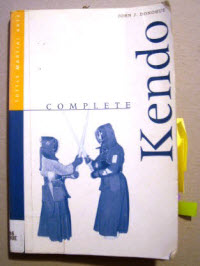You Got It!
Review: Complete Kendo by John J. Donohue

I actually did not think this book, Complete Kendo, was this good.
The author of this book, John J. Donohue, is an anthropologist who specialised in Japanese culture, history and language.
Needless to say, he brought up not only historical facts but also deep philosophical aspects of kendo. His understanding of kendo is real.
He covers etiquette and manners at the dojo, Japanese culture and kendo, basic techniques, kata and more.
He even explains how kendo and zen go together using examples of the historical figures such as Yamaoka Tesshu and others.
Unfortunately, there are not many pictures so it is not suitable if you are hoping to learn kendo by this book. He explains all the movements very well though.
Some Japanese words are not in the right form. Maybe typos.
p. 40: Hodoku. This should be "Toku". It is the same meaning and we use the same kanji for them. However, we pronounce differently.
In kendo we usually say, toku as in kamae wo toku. There may be some people who use "hodoku" in Japan. Where I come from, we always use "toku" for the action he describes in the book.
p.54: Nakayu-ki: I think he meant "nakayui".
p.152: Fudo Shinmyo Roku: It should be Fudochi Shinmyo Roku
Somewhere in the book, he says "sankyo", but it should be "sonkyo".
In the glossary (p.172), he says "saika tanden", it should be "seika tanden".
He calls tenugui as hachimaki. Somewhere in Japan they may call tenugui as hachimaki but hachimakiis more like a towel tied around the head, i.e. headband.
In my dojo in Japan, we used to call it "men towel", even thought it is obviously not a towel. Tenugui means a "hand wipe cloth".
I just wanted to point out that there are several ways to say "tenugui".
Again this book is not for those who are after learning techniques. But if you are looking for a book that gives you better understanding of kendo, I recommend this book.
This book is available at Amazon.
Return to Kendo Multimedia from Complete Kendo
Return to Kendo Guide from Complete Kendo
